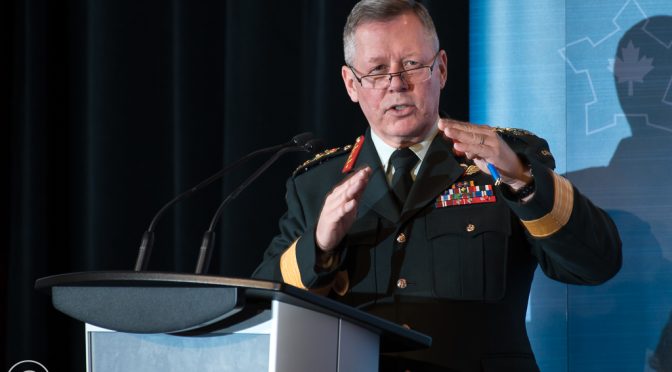If you are looking for pictures of speakers, CLICK HERE
“The Conference of Defence Associations (CDA) and CDA Institute (CDAI) promote research and informed public debate on national security and defence issues in support of credible government policies for Canada” (CDA statement) and hosted its annual Conference on Security and Defence at the Chateau Laurier Hotel on the 22nd/23rd February, 2018, with a theme of “Canadian Security and Defence in the New World (Dis)Order”. It was two days of opinion and research presentations on future challenges to the military, the changing world around us, speakers such as the Chief of Defence Staff, Gen. Jonathan Vance, and presentations from partner armed forces such as MGen Philippe Montocchio of France, and MGen Mitch Mitchell of the UK. Panelists covered topics of future defence challenges, the world disorder and the national capacity for defence with such noted panelists as Senator (Ret’d) Romeo Dallaire and LGen (USA Ret’d) Ben Hodges.
Suffice it to say that a blog post cannot do justice to any one topic covered by these august personages let alone two days of all-encompassing information so for a detailed account of what was covered one will have to wait for magazine articles to be published or more detailed reports to be submitted to websites. I can only briefly point out some of the highlights that resonated with me.
The first speaker was Mr. Darrell Bricker, of Ipsos Public Affairs, stating that he didn’t really have many opinions as his job was to measure opinions and then collate that into data. He would, therefore, speak to public opinion and counter with demographic hard data to provide a data base to consider all the issues being considered here with a specific reference to fertility and aging, urbanization, and multi-culturalism within Canadian and global populations.
He started by showing birthrate data from the 1950s and comparing it to today and then projecting out to 2036 and the changes that we are seeing. The number to remember is that in order to have a stable replacement of population you need a birthrate of 2.1 children per family (stable replacement birthrate or SRB). In the 1950s Canada had a birthrate of 4 but today is down to 1.6 projecting to be 1.2 by 2036. In short, we’ve stopped having children. And this is not just a Canadian phenomenon but is worldwide with places like India and China (accounting for 40% of the world’s population) already below SRB. In the ten most populous countries in the developed world, the birthrate has dropped by 60% in 50 years.
At the same time, people are living longer and the gross population is getting older. In Canada in the 1920s the average lifespan was 57 years, increasing to 81 years today and projecting to 87 years by 2036. In China in the 1950s the average lifespan was 40 years but has doubled to 80 years today. The median age of a Canadian today is 41 years whereas in the 1970s it was 24 years, and the developed countries now have more people alive over 65 years than under 15 years. As noted by Mr. Bricker, “[we’re] bad at making new people but really good at keeping people around” which explains why we’ve got an increasing global population that is getting top heavy with the elderly but thinning with the young people needed to replace them. As this trend continues it should result in a slight increase in the current global population before it starts to decline (due to deaths of the elderly without replacement young) which is a contradiction of United Nations projections of an 11 billion person global population by the year 2100.
Why has this happened? It’s not the one child rule in China which resulted in female infanticide which now leaves China with a deficit of child-bearing females in the population. The entire planet has stopped having larger families. Mr. Bicker cited the one overwhelming reason that he feels has led to this decline has to do with the increasing educating of women. To explain, in the early decades, women had little choices in their lives and got married in their 20s and started having children. However, now women get educated, start a career path, and get married later. By getting married later and having careers they have less biological time in which to have children and they spend more time advancing their careers than staying home to raise children. The result is that women have more choices and chose to have careers and less children and this trend does not reverse – ever.
What is the impact of this? In China the elderly rely on younger people to look after them as they don’t have a national pension. People will get old before they get rich enough to support the older population. This is true in Canada and globally as well. In Canada by 2036 there will be two people working for every retired person resulting in a huge drain on their tax dollars in supporting the federal pensions. It also means less young people available for armed forces and less skillsets to draw on for the new technological battlefield.
Population urbanization is also an issue as we are right now seeing the single biggest transformation in history of where the world is living and it has nothing to do with the mass migrations from war-torn countries. Currently, only 3% of the world lives in a country where they were not born so this type of migration, while seemingly overwhelming on the news, is not a real issue in terms of global population. The real issue is the move of population from rural areas to cities. In 1960, 34% of the population lived in cities and it now over 50% projecting to be 67% by 2050. Eight-two percent of Canadians live in towns with over 1,000 people with 40% of Canadians living in four cities. Ninety percent of Canadians live within 100 miles of the USA border. We are a hugely urban population. What this means in terms of sovereignty and our “Great White North” is that we are protecting land on which no-one lives or has probably seen and that we won’t have the people or resources to defend it.
Along with this is that fact that our country is changing demographically from one that faced east towards the Atlantic to one that faces west and the Pacific Ocean. Atlantic Canada is old with more people dying and no immigrants moving there. Those immigrants that do move there generally have left within five years. The Maritimes have the oldest populations, lowest birthrates, and fewest immigrants.
The Canadian population is more and more facing eastward to the Pacific as that is where people our moving. In the 1970s immigrants came primarily from the USA and UK but, with 1% immigration (the highest in the world per capita), today they come almost exclusively from the Pacific. And not so much from China anymore (they’re running out of young people to send and their middle class is gaining wealth at home) but from the Philippines. So previous immigration patterns from India and China have changed Canada’s global outlook eastward and future patterns would suggest a solidification of that pattern. Canada also is looking to increase trade with many of the Pacific Rim countries so politically this move continues.
The location pattern of immigrants has changed as well as in our past many immigrants moved out west to homestead. Now, immigrants move to cities for jobs and to be with cultural clusters within those cities. This only exacerbates the decline in rural population and increase in urbanization. But multi-culturalism is something that Canada does well with Toronto being the most multi-cultural city in the world with 50% of the population born in another country (London – 40%, Ottawa – 18%).
Along with these changes in population comes a change in where they see issues of concern. Almost all Canadians now see domestic issues topping their priorities such as ethnic violence, heath epidemics, domestic terrorism, and hacking, but national defence is not an issue concerning people. The only real national defence concern is cyber security so that our infrastructure and financial institutions are secure.
So, do these changing birthrates and urbanization have an effect on security and defence? They do. Because we don’t have a credible national threat people recognize that economic power may be more important than military power and this is leading our government to join more trade agreements. We are certainly more focused on new trade deals with Pacific countries as we have existing deals in place with European allies. Our remote regions may no longer be able to be secured by people but more remote monitoring systems may have to be put in place. We are living longer and healthier and that is going to have to change who and how the military recruits, the workplaces, and retirement. It also seems that what the military is designed to do and is good at, defending territory, is not of real concern to the population and their concerns on terrorism and cyber-security is not something with which the military has fully come to grips.
The best tagline of the entire conference comes from Mr. Bricker as he noted that we won’t be able to rely on young people to fight our wars as we won’t have enough of them. He stated, “We’re setup for a geriatric peace. We’re too old to fight.”
Gen. Vance started the second day with his state-of-the-union address and captured the audience of approximately 450 attendees with his easy podium style peppered with small bits of humour for which he is known. As it was his first opportunity to address a peer audience since the new Canadian Defence Policy, “Strong, Secure, Engaged (SSE)”, was presented he stated that “the policy will give us the flexibility to anticipate, adapt, and act in response to current and emerging threats with a new set of capabilities and a force of 101,500 regular and reserve that will tackle those challenges.”. He noted that the CAF will be manned to tackle up to nine concurrent international operations over and above domestic responsibilities as well as NATO and NORAD obligations which may require 7,000 troops at any one time, not including those required in North America, of which 4,000 will be capable of sustained operations and the remainder used for shorter operations. To put it in perspective Vance noted that currently Canada has 1800 troops deployed in 20 operations worldwide on any given day so this increase is vast.
Gen. Vance also covered where we are in various parts of the world such as Iraq and Daesh (it’s going to take time), a substantial return to Europe (NATO solidarity with Poland, Latvia, and Ukraine to send a message to Russia), and the possibility of future action in Africa.
At home he mentioned the successes of the CAF aiding civilian powers in helping with the Quebec floods and B.C. forest fires, search and rescue ops, and assistance to hurricane victims. He noted that new investments in equipment and infrastructure is necessary to carry out the new policy ($108 billion over 20 years) and procurement was underway for LAVs, combat vehicles (TAPVs), ships (Halifax class modernization), aircraft, and $250 million for the ISS (integrated soldier systems).
To do all this Canada will need more people and stated for the first time in a long time that the CAF is growing. But growing is not enough and that Canada needs the right kind of people and needs more diversity, including women, in that growth. Mentioning the Reserves, he stated historically the Reserves have augmented the Regular forces but now needs to become a larger Reserve force of part time soldiers who have 24/7 full-time capability to compliment the Regular force to carry out the increased numbers of deployments simultaneously and sustain them.
Lastly, Vance focused on personnel and their experiences from entry to exit into the CAF and admitted that more needs to be done. He spoke of soldiers who had suffered trauma (both physical and mental) possibly not being released so quickly as, although they may not be deployable at the moment, they are still employable. Personnel should be eligible for promotion while on parental leave or seeking medical treatment and soldiers on named operations overseas should be eligible for tax considerations without having to demonstrate a level of risk as before. There is a need to improve the relocation policies and benefits to align them with the current economic realities. In all, he envisions many changes to support CAF personnel.
Again, this does not even begin to cover to speakers mentioned above nor even attempt to cover the scope of the conference. For that you must turn to other sources, such as the CDA and CDAI themselves.
to see all the pictures, CLICK HERE
==================================================
















